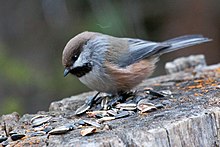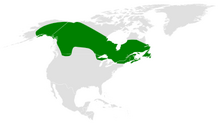Boreal chickadee
| Boreal chickadee | |
|---|---|

| |
| Scientific classification | |
| Domain: | Eukaryota |
| Kingdom: | Animalia |
| Phylum: | Chordata |
| Class: | Aves |
| Order: | Passeriformes |
| Family: | Paridae |
| Genus: | Poecile |
| Species: | P. hudsonicus
|
| Binomial name | |
| Poecile hudsonicus (Forster, 1772)
| |

| |
| Range of Poecile hudsonicus | |
| Synonyms | |
|
Parus hudsonicus | |
The boreal chickadee (Poecile hudsonicus) is a small passerine bird in the tit family Paridae. It is found in the boreal forests of Canada and the northern United States.
Description
Adults are 12.5–14.5 cm (4.9–5.7 in) long with a weight of 7–12.4 g (0.25–0.44 oz). They have grey-brown upperparts with a brown cap and greyish wings and tail; their face is mainly grey with white on the sides. Their underparts are white with brown on the flanks and a black throat. They have a short dark bill, short wings and a long notched tail.
| Standard Measurements[2][3] | |
|---|---|
| length | 130–140 mm (5–5.5 in) |
| weight | 10 g (0.35 oz) |
| wingspan | 210 mm (8.25 in) |
| wing | 63.2–66.2 mm (2.49–2.61 in) |
| tail | 59–65.9 mm (2.32–2.59 in) |
| culmen | 7.6–9.8 mm (0.30–0.39 in) |
| tarsus | 16–17.5 mm (0.63–0.69 in) |
The call is a husky tsik-a-dee-dee, a variant on the call which gives chickadees their name.
Behavior
Their breeding habitat is coniferous woods in Canada, Alaska, and the northern edges of the northernmost portions of the lower forty-eight United States. They remain within their breeding range throughout the year, but sometimes move south in winter. Winter movements south of their range, however, appear to have become increasingly rare. They nest in a hole in a tree; the pair excavates the nest, using a natural cavity or sometimes an old woodpecker nest. Five to seven eggs are laid, white with fine reddish-brown spotting.[2] The pair remains together year round and may mate for life.
These birds forage on conifer branches or probe into the bark, eating mainly insects and seeds, which may be stored for later use. They often forage in small flocks including other small birds, especially in winter.
Taxonomy
Often, it is still placed in the genus Parus with most other tits, but mtDNA cytochrome b sequence data and morphology suggest that separating Poecile more adequately expresses these birds' relationships.[4] The American Ornithologists' Union has been treating Poecile as a distinct genus for some time already. The genus name Poecile has often been treated as feminine (giving the species name ending hudsonica); however, this was not specified by the original genus author Johann Jakob Kaup, and under the ICZN the genus name must therefore be treated by default as masculine, giving the name ending hudsonicus.[5]
References
- ^ Template:IUCN
- ^ a b Godfrey, W. Earl (1966). The Birds of Canada. Ottawa: National Museum of Canada. pp. 279–280.
- ^ Sibley, David Allen (2000). The Sibley Guide to Birds. New York: Knopf. p. 376. ISBN 0-679-45122-6.
- ^ Gill, F.B.; Slikas, B.; Sheldon, F.H. (2005). "Phylogeny of titmice (Paridae): II. Species relationships based on sequences of the mitochondrial cytochrome-b gene". Auk. 122: 121–143. doi:10.1642/0004-8038(2005)122[0121:POTPIS]2.0.CO;2.
- ^ del Hoyo, J.; Elliot, A.; Christie, D., eds. (2007). Handbook of the Birds of the World. Vol. 12: Picathartes to Tits and Chickadees. Barcelona: Lynx Edicions. ISBN 978-84-96553-42-2.
External links
- Boreal chickadee Species Account – Cornell Lab of Ornithology
- Canadian boreal chickadee stamp at www.bird-stamps.org
- Boreal chickadee photo gallery at VIREO (Drexel University)
- Article on "Maine's Boreal Species" at the Maine Birding Trail
- BirdLife species factsheet for Parus hudsonicus
- "Poecile hudsonicus". Avibase.
- "Boreal chickadee media". Internet Bird Collection.
- Interactive range map of Parus hudsonicus at IUCN Red List maps
- Audio recordings of Boreal chickadee on Xeno-canto.
- Poecile hudsonicus in Field Guide: Birds of the World on Flickr
- Boreal chickadee media from ARKive

